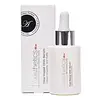What's inside
What's inside
 Key Ingredients
Key Ingredients

 Benefits
Benefits

 Concerns
Concerns

 Ingredients Side-by-side
Ingredients Side-by-side

Water
Skin ConditioningCaprylic/Capric Triglyceride
MaskingC12-15 Alkyl Benzoate
AntimicrobialCetearyl Ethylhexanoate
EmollientGlycerin
HumectantCocos Nucifera Oil
MaskingShorea Stenoptera Seed Butter
EmollientCetearyl Alcohol
EmollientCetearyl Glucoside
EmulsifyingCyclopentasiloxane
EmollientCetyl Alcohol
EmollientGlyceryl Stearate
EmollientPhenoxyethanol
PreservativePanthenol
Skin ConditioningSea Water
HumectantEthylhexyl Methoxycinnamate
UV AbsorberTocopheryl Acetate
AntioxidantDimethiconol
EmollientParfum
MaskingPotassium Cetyl Phosphate
EmulsifyingChlorphenesin
AntimicrobialHydroxypropyl Guar
Emulsion StabilisingAcrylates/C10-30 Alkyl Acrylate Crosspolymer
Emulsion StabilisingDisodium EDTA
O-Cymen-5-Ol
AntimicrobialHydrolyzed Algin
Sodium Dehydroacetate
PreservativeSodium Hyaluronate
HumectantSodium Hydroxide
BufferingBenzyl Salicylate
PerfumingSodium Carboxymethyl Betaglucan
Sucrose
HumectantLimonene
PerfumingBHA
AntioxidantBHT
AntioxidantCitric Acid
BufferingPropyl Gallate
AntioxidantWater, Caprylic/Capric Triglyceride, C12-15 Alkyl Benzoate, Cetearyl Ethylhexanoate, Glycerin, Cocos Nucifera Oil, Shorea Stenoptera Seed Butter, Cetearyl Alcohol, Cetearyl Glucoside, Cyclopentasiloxane, Cetyl Alcohol, Glyceryl Stearate, Phenoxyethanol, Panthenol, Sea Water, Ethylhexyl Methoxycinnamate, Tocopheryl Acetate, Dimethiconol, Parfum, Potassium Cetyl Phosphate, Chlorphenesin, Hydroxypropyl Guar, Acrylates/C10-30 Alkyl Acrylate Crosspolymer, Disodium EDTA, O-Cymen-5-Ol, Hydrolyzed Algin, Sodium Dehydroacetate, Sodium Hyaluronate, Sodium Hydroxide, Benzyl Salicylate, Sodium Carboxymethyl Betaglucan, Sucrose, Limonene, BHA, BHT, Citric Acid, Propyl Gallate
Water
Skin ConditioningShea Butter Ethyl Esters
EmollientBrassica Glycerides
EmollientPropanediol
SolventButylene Glycol
HumectantGlyceryl Stearate Se
EmulsifyingBehenyl Alcohol
EmollientPhenoxyethanol
PreservativeGlycerin
HumectantPullulan
Hydrolyzed Hyaluronic Acid
HumectantButyrospermum Parkii Butter
Skin ConditioningSodium Hyaluronate
HumectantLecithin
EmollientSodium Acrylates Copolymer
Nannochloropsis Oculata Extract
HumectantHippophae Rhamnoides Fruit Oil
Skin ProtectingDisodium EDTA
Sodium Hydroxymethylglycinate
PreservativeRetinal
Skin ConditioningEthylhexylglycerin
Skin ConditioningLysolecithin
EmulsifyingSclerotium Gum
Emulsion StabilisingTocopherol
AntioxidantDimethylmethoxy Chromanol
AntioxidantXanthan Gum
EmulsifyingAcetyl Glutamine
Skin ConditioningGlycine Soja Oil
EmollientPotassium Sorbate
PreservativeSodium Benzoate
MaskingBacillus/Folic Acid Ferment Filtrate Extract
AntioxidantCaprylyl Glycol
Emollient1,2-Hexanediol
Skin ConditioningAcetyl Hexapeptide-51 Amide
Skin ConditioningSh-Oligopeptide-1
Skin ConditioningSh-Oligopeptide-2
Skin ConditioningSh-Polypeptide-1
Skin ConditioningSh-Polypeptide-9
Skin ConditioningSh-Polypeptide-11
Citric Acid
BufferingWater, Shea Butter Ethyl Esters, Brassica Glycerides, Propanediol, Butylene Glycol, Glyceryl Stearate Se, Behenyl Alcohol, Phenoxyethanol, Glycerin, Pullulan, Hydrolyzed Hyaluronic Acid, Butyrospermum Parkii Butter, Sodium Hyaluronate, Lecithin, Sodium Acrylates Copolymer, Nannochloropsis Oculata Extract, Hippophae Rhamnoides Fruit Oil, Disodium EDTA, Sodium Hydroxymethylglycinate, Retinal, Ethylhexylglycerin, Lysolecithin, Sclerotium Gum, Tocopherol, Dimethylmethoxy Chromanol, Xanthan Gum, Acetyl Glutamine, Glycine Soja Oil, Potassium Sorbate, Sodium Benzoate, Bacillus/Folic Acid Ferment Filtrate Extract, Caprylyl Glycol, 1,2-Hexanediol, Acetyl Hexapeptide-51 Amide, Sh-Oligopeptide-1, Sh-Oligopeptide-2, Sh-Polypeptide-1, Sh-Polypeptide-9, Sh-Polypeptide-11, Citric Acid
Ingredients Explained
These ingredients are found in both products.
Ingredients higher up in an ingredient list are typically present in a larger amount.
Citric Acid is an alpha hydroxy acid (AHA) naturally found in citrus fruits like oranges, lemons, and limes.
Like other AHAs, citric acid can exfoliate skin by breaking down the bonds that hold dead skin cells together. This helps reveal smoother and brighter skin underneath.
However, this exfoliating effect only happens at high concentrations (20%) which can be hard to find in cosmetic products.
Due to this, citric acid is usually included in small amounts as a pH adjuster. This helps keep products slightly more acidic and compatible with skin's natural pH.
In skincare formulas, citric acid can:
While it can provide some skin benefits, research shows lactic acid and glycolic acid are generally more effective and less irritating exfoliants.
Most citric acid used in skincare today is made by fermenting sugars (usually from molasses). This synthetic version is identical to the natural citrus form but easier to stabilize and use in formulations.
Read more about some other popular AHA's here:
Learn more about Citric AcidDisodium EDTA plays a role in making products more stable by aiding other preservatives.
It is a chelating agent, meaning it neutralizes metal ions that may be found in a product.
Disodium EDTA is a salt of edetic acid and is found to be safe in cosmetic ingredients.
Learn more about Disodium EDTAGlycerin is already naturally found in your skin. It helps moisturize and protect your skin.
A study from 2016 found glycerin to be more effective as a humectant than AHAs and hyaluronic acid.
As a humectant, it helps the skin stay hydrated by pulling moisture to your skin. The low molecular weight of glycerin allows it to pull moisture into the deeper layers of your skin.
Hydrated skin improves your skin barrier; Your skin barrier helps protect against irritants and bacteria.
Glycerin has also been found to have antimicrobial and antiviral properties. Due to these properties, glycerin is often used in wound and burn treatments.
In cosmetics, glycerin is usually derived from plants such as soybean or palm. However, it can also be sourced from animals, such as tallow or animal fat.
This ingredient is organic, colorless, odorless, and non-toxic.
Glycerin is the name for this ingredient in American English. British English uses Glycerol/Glycerine.
Learn more about GlycerinPhenoxyethanol is a preservative that has germicide, antimicrobial, and aromatic properties. Studies show that phenoxyethanol can prevent microbial growth. By itself, it has a scent that is similar to that of a rose.
It's often used in formulations along with Caprylyl Glycol to preserve the shelf life of products.
Sodium Hyaluronate is hyaluronic acid's salt form. It is commonly derived from the sodium salt of hyaluronic acid.
Like hyaluronic acid, it is great at holding water and acts as a humectant. This makes it a great skin hydrating ingredient.
Sodium Hyaluronate is naturally occurring in our bodies and is mostly found in eye fluid and joints.
These are some other common types of Hyaluronic Acid:
Learn more about Sodium HyaluronateWater. It's the most common cosmetic ingredient of all. You'll usually see it at the top of ingredient lists, meaning that it makes up the largest part of the product.
So why is it so popular? Water most often acts as a solvent - this means that it helps dissolve other ingredients into the formulation.
You'll also recognize water as that liquid we all need to stay alive. If you see this, drink a glass of water. Stay hydrated!
Learn more about Water